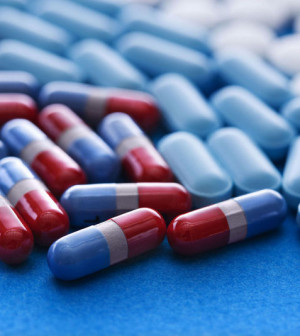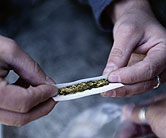- Skip Storing This Everyday Product in the Fridge Door
- Green Tea + B3 Pairing May Boost Brain Health
- Navigating Your Midlife Crisis: Embracing New Possibilities
- City Raccoons Showing Signs of Domestication
- Mapping the Exposome: Science Broadens Focus to Environmental Disease Triggers
- One Week Less on Social Media Linked to Better Mental Health
- Your Brain Changes in Stages as You Age, Study Finds
- Some Suicide Victims Show No Typical Warning Signs, Study Finds
- ByHeart Formula Faces Lawsuits After Babies Sickened With Botulism
- Switch to Vegan Diet Could Cut Your Greenhouse Gas Emissions in Half
More College Kids Smoke Pot Now Than Cigarettes, Survey Finds


On college campuses nationwide, daily cigarette smoking appears to be in steep decline while the rate of smoking pot each day climbs, well, higher.
In fact, a new study shows that, for the first time, more U.S. college students (6 percent) now smoke a joint each day than light up a cigarette (5 percent).
The findings are based on 2014 data collected from more than a thousand college students across the country. The Monitoring the Future study, which has tracked trends on college campuses for 41 years, is funded by the U.S. National Institutes on Drug Abuse.
“It’s clear that for the past seven or eight years there has been an increase in marijuana use among the nation’s college students,” study leader Lloyd Johnston, a research professor at the University of Michigan, said in a university news release.
“This largely parallels an increase we have been seeing among high school seniors,” Johnston added.
Marijuana use by college students has been growing steadily since 2006, his team noted.
For example, while about 3.5 percent of students said they smoked pot daily or almost daily in 2007, that number had risen to about 6 percent — about one in every 17 students — in the latest survey.
Other college students are using pot, but less regularly. The research showed that the proportion of college students who said they had used the drug once or more in the previous month rose from 17 percent in 2006 to 21 percent in 2014, while the rate of marijuana within the prior year rose from 30 percent in 2006 to 34 percent in 2014, the study found.
Tobacco smoking has headed in the opposite direction, however. While 19 percent of college kids said they were daily smokers in 1999, only 5 percent said that by 2014, Johnston’s team reported.
The rise in marijuana use on college campuses may be tied to the notion among a growing number of teens and young adults that the drug isn’t dangerous, the team said.
For example, the proportion of American high school graduates aged 19 to 22 who considered marijuana harmful fell from 55 percent in 2006 to 35 percent in 2014, the study found.
But for the first time in years, the study actually recorded a slight drop in the use of illegal substances overall.
“There is some more welcome news for parents as they send their children off to college this fall,” Johnston said. “Perhaps the most important is that five out of every 10 college students have not used any illicit drug in the past year, and more than three quarters have not used any in the prior month.”
The rate at which college students’ said they had used any illicit drug, including marijuana, over the prior year had been rising steadily: from 34 percent in 2006 to 41 percent in 2013. However it fell slightly in the 2014 survey, to 39 percent.
Still, the use of illicit drugs other than pot continues to grow. College students’ use of any illicit drug other than marijuana in the previous 12 months rose from 15 percent in 2008 to 21 percent by 2014, Johnston’s team said. Most of this increase is due to greater illicit use of amphetamines and ecstasy, the researchers said.
Non-medical use of amphetamines over the previous 12 months increased from almost 6 percent in 2008 to 11 percent in 2012, and fell to 10 percent in 2014.
“It seems likely that this increase in amphetamine use on the college campus resulted from more students using these drugs to try to improve their studies and test performance,” Johnston said. For example, some people may try amphetamine-based ADHD medications such as Adderall as a “study aid” to help them focus.
Past-year ecstasy use rose from just over 2 percent in 2007 to almost 6 percent in 2012, and remained about the same in 2014. Cocaine use within the previous 12 months rose from close to 3 percent in 2013 to slightly more than 4 percent in 2014.
“We are being cautious in interpreting this one-year increase, which we do not see among high school students; but we do see some increase in cocaine use in other young adult age bands, so there may in fact be an increase in cocaine use beginning to occur,” Johnston said.
Non-medical use of narcotic drugs — which include prescription painkillers such as Oxycontin and Vicodin — fell from almost 9 percent in 2006 to close to 5 percent in 2014, the report said. Very few college students use heroin, the researchers noted, and use of the drug over the past five years on campuses was lower than in the late 1990s and early 2000s.
Non-medical use of tranquilizers decreased from almost 7 percent in 2003 to 3.5 percent in 2014, and rates of use of LSD and other hallucinogenic drugs in 2014 were just over 2 percent and 3 percent, respectively. College students’ use of club drugs and bath salts are very low.
And even though drinking rates remain very high, rates of drunkenness actually fell in 2014.
According to the study, the proportion of students who said they had alcohol at least once in the past month fell from 82 percent in 1981 to 67 percent in 2000 and to 63 percent in 2014. The proportion who said they had gotten drunk over the past month also fell, from 48 percent in 2006 to 43 percent in 2014.
Rates of binge drinking — five or more drinks in a row — within the past two weeks fell from 44 percent in 1980 to 35 percent in 2014.
However, “despite the modest improvements in drinking alcohol at college, there are still a sizable number of students who consume alcohol at particularly dangerous levels,” Johnston said.
More information
The U.S. Centers for Disease Control and Prevention has more about college health and safety.
Source: HealthDay
Copyright © 2025 HealthDay. All rights reserved.










